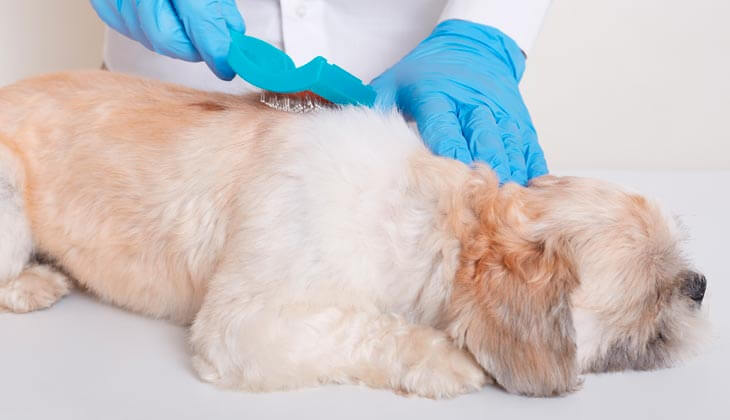Your dog’s hair is falling out and it seems to be more than normal shedding. In fact, there may even be some spots on the body where skin is visible. It’s likely your dog has any of a number of conditions that fall under the general name “alopecia,” which simply means “balding.” While it’s not unusual for men to go bald, hair loss in male or female dogs is usually a sign that there is an underlying problem.
CAUSES OF HAIR LOSS IN DOGS
There are a number of reasons why your dog could be losing his or her hair and you will want to schedule a visit to your veterinarian to investigate the possible underlying causes and develop a treatment plan.
GENETICS
The cause of your dog’s hair loss may be related to his or her genetic make-up. Hair loss can result from a lack of normal development of the hair follicles. You might notice this when your dog is a puppy and his or her coat fails to grow in fully. Or, your pooch may have been born with a normal coat and when he or she becomes a young adult, there could be patchy or widespread hair loss.
And sometimes, it’s normal for your dog to develop bald patches as they get older. Greyhounds, Whippets, Chihuahuas, Dachshunds and Italian Greyhounds are all susceptible to losing hair on the outer ear, chest, belly, thighs or lower neck as they a
NUTRITION
Dogs can suffer hair loss when they do not receive a complete diet. Commercial foods will almost always provide the nutritional balance your dog needs to prevent this problem, but if you home cook your dog’s meals, you need to ensure the meals are properly balanced for your pup.

Pregnancy
Pregnant and nursing dogs sometimes experience temporary hair loss due to hormonal changes. This hair loss usually stops when the hormones return to non-reproductive levels, after the period of pregnancy and nursing is over.
HYPOTHYROIDISM
It’s a common cause of hair coat changes in dogs and is a result of an under-active thyroid, although there are other causes. In this condition, decreased levels of thyroid hormones result in a slower metabolic rate. Most cases of hypothyroidism in dogs are caused by an apparently auto-immune destruction of the thyroid gland itself. Another potential cause is a tumour on the pituitary gland at the base of the brain, which can lead to deficiencies of other pituitary hormones as well.
Dogs with hypothyroidism generally exhibit signs on their skin and coat, including dryness and excessive shedding with delayed regrowth of hair. They may also have thinning or loss of hair in the same pattern on both sides of the body. Collection of blood for testing may be needed to confirm the diagnosis.
CUSHING’S DISEASE
It is another common cause of hair loss in dogs. With this condition, related to function of the adrenal gland cortex, your dog’s body makes too much of a hormone called cortisol. This leads to a weakened immune system and other changes that potentially leave the dog vulnerable to other diseases and infections. This disease develops slowly and usually occurs in middle-aged to older dogs. Early signs are not always noticed but the clinical signs can include fragile or thin skin, hair loss and recurrent skin infections.
FLEAS
Flea bites are itchy and annoying for your pet, causing him or her to be restless, biting at their skin, scratching and licking incessantly. Some dogs are also very allergic to flea saliva, and these dogs can develop a severe reaction to bites from these pesky skin parasites. Signs of flea allergy in dogs include reddened, crusty, itchy skin on the hips, base of the tail and thighs. This often leads to hair loss, scabbing and secondary infections. As the condition becomes chronic, hair loss, thickened and darkening skin are seen.
Looking for a Vet?
Your veterinarian plays a big role in your pet’s health. Input your location information and get a list of veterinarians near you.
Find A Vet Near MeMITES/MANGE
Mange is a skin disease that occurs when your pup’s skin becomes infested with one of several different species of mites that embed themselves either in or on your dog’s skin or in the hair follicles. The mites cause irritation of the skin, resulting in itching, hair loss and inflammation. While dog mange is usually treatable, some forms are highly contagious.
CANINE SCABIES
Highly contagious, canine scabies is caused by a specific mite called Sarcoptes scabiei var canis. This itchy little parasite causes intense itching that comes on suddenly with small, solid bumps infesting the skin. As your dog scratches or bites to relieve the itch, these bumps and surrounding skin can become damaged, causing thick, crusted sores. These mites can spread to bite people also.
EAR MITES
This form of mange in dogs is caused by mites known as Otodectes cynotis, which infest the external ear canal – the part of the ear between the ear flap that you can see and the ear drum, which you cannot easily see. These mites cause inflammation of the lining of this ear canal. They are sometimes found on the body as well.
WALKING DANDRUFF (CHEYLETIELLOSIS)
Caused by the Cheyletiella yasguri mites, these itchy critters commonly cause intense itching and scaling of the skin along the back.
CANINE DEMODICOSIS
These mites, called Demodex canis, are often found in small numbers in the hair follicles of all dogs and are perfectly normal, causing no sign of disease. Under some circumstances, dogs may become infested with large numbers of these mites, resulting in hair loss and inflammation. The reasons that this occurs are variable and not always known, with some evidence of hereditary predisposition for the condition, causing a weakened immune system response to the mites.
TROMBICULOSIS
This type of mite looks like tiny spiders and may sometimes be seen on your pet as tiny, orange-red dots. They frequently cluster on the head, ears, feet or belly. Signs of infestation are often an allergic reaction to the mites and include redness, bumps, hair loss and crusty skin. Intense itching can be associated with this problem. They are often reported in autumn and sometimes called harvest mites.
ALLERGIES
Like people, dogs can be allergic to various substances in their environment, such as pollen or mould, or to substances in food. These allergy-inducing substances are called allergens.
Any dog of any breed can be allergic and onset of allergies is usually between 6 months to 3 years. Sometimes signs are seasonal and sometimes they can be seen all year. These signs can include intense itching around the feet, face, ears, front legs and abdomen. Scratching can lead to secondary issues such as scabbing, skin and ear infections, hair loss and scaly skin.

SKIN INFECTIONS
Another ailment that people and dogs share, bacterial or fungal infections on the skin can result in irritation in your dog and possibly hair loss.
PYODERMA
Bacterial infections often begin with broken skin as a result of scratching or from flea bites. Sometimes the skin is red and there may be local collections of pus under the skin similar to pimples seen on people’s skin.
YEAST INFECTIONS/MALASSEZIA
These infections can occur when the yeast that is present normally on dogs’ skin becomes overgrown. These infections can cause skin irritation and open sores, as well as hair loss.
RINGWORM
Also known as “tinea,” this is not actually a worm, but a fungal infection of the hair and hair shafts that gets its name from the round patches of flaky skin and broken hairs that result.
Remember…
This is not a complete list and there are further potential causes for hair loss to consider.
TREATMENT FOR DOG HAIR LOSS
The first step in addressing any concern about hair loss is to take your dog to the veterinarian to start working on an accurate diagnosis of the cause. This will require a detailed history and a physical examination. Key points in the history will include your dog’s breed and tendencies for congenital or hereditary hair loss, as well as information from you concerning the presence, duration and progression of the problem and if your dog has been itching or not. Your veterinarian will look for evidence of infection and check your pooch’s general health.
The veterinarian will often also examine the hairs themselves, usually taking a few for a look under the microscope. This examination can help to determine if the hairs are being shed from the follicle, or if they are being broken off. Your veterinarian may also perform skin scrapings to look for parasites or infections and/or comb your dog’s coat for fleas, mites and lice. The skin scrapings and materials from the combing may be sent to a laboratory for further testing. Occasionally a referral to a specialist in veterinary dermatology may be needed to reach a final diagnosis.
Successful treatment of your dog’s hair loss depends on correctly identifying the underlying cause leading to a specific diagnosis. Remedies could include medications, antibiotics, creams, shampoos or prophylactic regimens such as flea and tick preventatives.
If you see any indication of hair loss in your beloved pooch, it’s a good idea to see your veterinarian to rule out various causes including potentially serious conditions that may become worse if not effectively addressed.






 Go To United States
Go To United States Austria
Austria Belgium
Belgium Czech Republic
Czech Republic Denmark
Denmark Europe
Europe Finland
Finland France
France Germany
Germany Greece
Greece Hungary
Hungary Ireland
Ireland Israel
Israel Italy
Italy Netherlands
Netherlands Norway
Norway Poland
Poland Portugal
Portugal Romania
Romania Saudi Arabia
Saudi Arabia Slovakia
Slovakia Spain
Spain Sweden
Sweden Switzerland
Switzerland Turkey
Turkey United Kingdom
United Kingdom